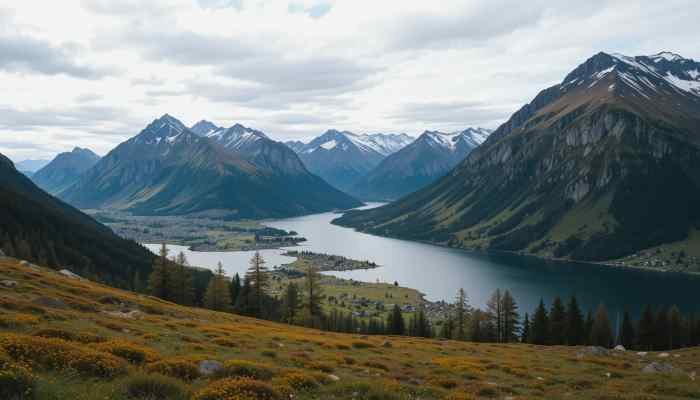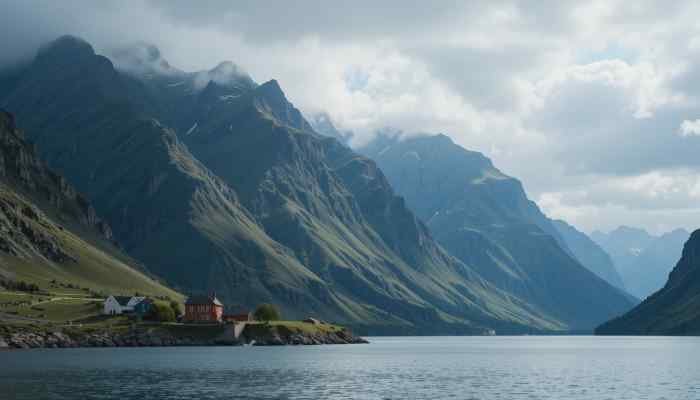
Explore Norway Mountains: Top Peaks, Trails & Travel Tips
Introduction to Norway Mountains
Norway Mountains are some of the most breathtaking natural features in Europe. Known for their rugged beauty and dramatic landscapes, these mountains form a significant part of Norway’s identity and appeal. Stretching across much of the country, Norway Mountains ranges offer a mix of sharp peaks, deep valleys, and expansive plateaus. The unique geography of these mountains shapes the country’s climate, wildlife, and culture.
Visitors from around the world come to explore Norway’s mountains for hiking, skiing, and enjoying the spectacular fjord views. Whether you are an experienced mountaineer or a casual traveler, Norway’s mountains offer something for everyone — from challenging climbs to peaceful nature walks. The pristine environment combined with well-preserved trails makes Norway a paradise for nature lovers.
Top Mountain Ranges in Norway
Norway’s diverse mountain ranges provide incredible scenery and adventure opportunities. The main Norway Mountains ranges include:
-
Scandinavian Mountains (Scandes): This vast range stretches across Norway and Sweden and is characterized by high plateaus and sharp peaks. It’s the backbone of Norway’s mountain landscape.
-
Jotunheimen Mountains: Known as the “Home of the Giants,” this range includes the country’s tallest peaks. It is popular for hiking, mountaineering, and wildlife spotting.
-
Trollheimen Mountains: Meaning “Home of the Trolls,” this lesser-known range features wild, untouched terrain with many lakes and forests, perfect for off-the-beaten-path explorers.
-
Lyngen Alps: Located in northern Norway, the Lyngen Alps offer jagged peaks and are a hotspot for skiing and alpine climbing.
Each mountain range has its unique charm and caters to different types of outdoor activities, making Norway’s mountains a versatile destination for adventurers.
Highest Peaks in Norway
Norway is home to several towering peaks that attract climbers and nature enthusiasts. The highest mountain in Norway is Galdhøpiggen, standing at 2,469 meters (8,100 feet). It is located in the Jotunheimen range and offers well-marked trails for hikers of all skill levels. Another prominent peak is Glittertind, slightly lower at 2,465 meters but equally impressive, often covered in snow. These mountains provide panoramic views of the surrounding landscape and glaciers. Other notable peaks include Store Skagastølstind and Surtningssue, both over 2,300 meters high.
These summits challenge experienced climbers with rocky ridges and steep ascents but reward them with some of the most spectacular mountain vistas in Northern Europe. Norway’s peaks are not only natural wonders but also an important part of Norwegian culture and outdoor tradition.
Best Hiking Trails in Norway Mountains
Norway offers some of the best hiking experiences in Europe, with trails suitable for beginners and experienced hikers alike. Here are some popular hiking trails:
-
Besseggen Ridge (Jotunheimen): Famous for stunning views over turquoise lakes and jagged peaks.
-
Rondane National Park Trails: Well-marked routes through peaceful valleys and rolling mountains.
-
Innerdalen Valley (Trollheimen): Known as one of Norway’s most beautiful valleys, ideal for a scenic hike.
-
Reisa National Park (Lyngen Alps): Offers remote hiking with waterfalls, rivers, and alpine terrain.
Hiking in Norway’s mountains is a fantastic way to connect with nature. Trails are well-maintained, and many have mountain huts (called “hytter”) where hikers can rest or stay overnight. The best time for hiking usually ranges from June to September, when the weather is milder and trails are free of snow.
Also Read: Perfect Amalfi Coast Tours: Tips, Towns & Highlights 2025
Winter Sports and Skiing in Norway’s Mountains

Norway Mountains transform into a winter sports paradise during the snowy season. The country is famous for its skiing culture, and mountain resorts offer activities for all skill levels. Popular ski areas include:
-
Trysil: Norway’s largest ski resort, with varied slopes and modern facilities.
-
Hemsedal: Known as the “Scandinavian Alps,” offering challenging terrain and great powder snow.
-
Geilo: A family-friendly resort ideal for beginners and cross-country skiing.
In addition to alpine skiing, Norway offers cross-country skiing, snowboarding, snowshoeing, and even dog sledding. The consistent snowfall and well-maintained trails make Norway a top choice for winter enthusiasts. Many resorts also offer cozy cabins and après-ski activities, making the mountain winter experience both thrilling and comfortable.
Flora and Fauna of Norway’s Mountain Regions
The mountain regions of Norway boast a rich variety of flora and fauna adapted to the harsh climate and rugged terrain. Alpine plants like moss campion, mountain avens, and arctic willow thrive in these high-altitude areas, adding delicate bursts of color during the short summer months. Wildlife includes species such as reindeer, musk ox, arctic fox, and mountain hare. Birdwatchers can spot golden eagles, ptarmigans, and various species of grouse.
Norway’s mountains are part of several protected national parks, preserving the natural habitats and biodiversity. The changing seasons bring different wildlife activity — from animal migrations in spring to hibernation in winter — making it an exciting place for nature observers. The balance between preservation and tourism helps maintain this unique ecosystem.
How to Prepare for a Mountain Trip in Norway
Preparing for a trip to Norway’s mountains requires careful planning to ensure safety and comfort. Key tips include:
-
Gear: Pack layered clothing for changing weather, sturdy hiking boots, a waterproof jacket, and sun protection.
-
Safety: Carry a map, compass or GPS, and let someone know your itinerary. Check weather forecasts regularly.
-
Timing: The best time for hiking is between June and September; winter activities are best from December to March.
-
Physical Fitness: Some trails are challenging; being in good shape improves your experience.
-
Local Regulations: Respect protected areas and follow Leave No Trace principles.
Preparation helps you enjoy Norway’s mountains fully and safely, whether you’re hiking, skiing, or simply exploring.
Accommodation and Facilities Near Norway Mountains
Norway Mountains regions offer a variety of accommodation options to suit different traveler preferences. You can find cozy mountain cabins, known as “hytter,” which are popular for their rustic charm and proximity to trails. Many are available for rent through the Norwegian Trekking Association (DNT), providing basic amenities in beautiful locations. For more comfort, mountain lodges offer full services including meals, guided tours, and comfortable rooms.
Camping is also common, especially in designated campsites that provide facilities like toilets and fire pits. In larger ski resorts, hotels and resorts cater to tourists year-round with modern conveniences. Facilities such as visitor centers, equipment rentals, and guided tour services make traveling in Norway’s mountains convenient and enjoyable.
Famous Fjords and Their Mountain Surroundings
Norway’s fjords are world-renowned, often framed by towering mountains that enhance their dramatic beauty. Some of the most famous fjords with spectacular mountain views include:
| Fjord | Location | Mountain Highlights |
|---|---|---|
| Geirangerfjord | Western Norway | Surrounded by steep cliffs and waterfalls |
| Sognefjord | Southern Norway | Deep fjord with jagged mountain peaks |
| Nærøyfjord | Part of Sognefjord | Narrow fjord flanked by steep mountains |
The steep cliffs rising from the fjord waters create postcard-perfect scenery. These areas are popular for boat tours, hiking, and photography. The combination of fjords and mountains makes Norway a unique travel destination for nature lovers.
Cultural and Historical Significance of Norway Mountains
Norway Mountains are not only natural wonders but also hold deep cultural and historical importance. The indigenous Sami people have lived in the mountain regions for centuries, maintaining a strong connection to the land through reindeer herding and traditional crafts. Many mountain areas are rich with folklore featuring trolls, giants, and other mythical creatures, reflecting the awe the mountains inspired in local communities. Historically, mountains served as natural borders and strategic locations during times of conflict.
Today, the mountains continue to shape Norwegian identity, inspiring art, literature, and outdoor lifestyles. Festivals and events celebrating mountain culture take place regularly, highlighting the ongoing relationship between people and the natural landscape.
Tips for Photographers: Capturing Norway’s Mountain Beauty

Photographers visiting Norway’s mountains have endless opportunities to capture stunning landscapes. Here are some tips:
-
Best Times: Early morning and late evening (golden hours) provide soft, warm light.
-
Seasons: Autumn offers vibrant foliage, while winter creates magical snowy scenes.
-
Locations: Besseggen Ridge, Trollheimen, and fjord viewpoints like Geirangerfjord are top spots.
-
Equipment: Use a wide-angle lens for landscapes and a tripod for stability in low light.
-
Weather: Be prepared for changing weather and bring protective gear for your camera.
By following these tips, photographers can capture the majestic beauty and unique atmosphere of Norway’s mountains.
Also Read: Daily Gate City – Keokuk’s Historic Voice Since 1855
Conclusion: Why Norway Mountains Should Be on Your Travel List
Norway Mountains offer a perfect blend of breathtaking scenery, outdoor adventure, and rich cultural heritage. From the towering peaks of Jotunheimen to the tranquil beauty of the fjords, there is something for every traveler. The well-maintained trails and welcoming mountain lodges make exploring accessible and comfortable, while the chance to witness unique flora, fauna, and Sami traditions adds depth to the experience.
Whether you seek adrenaline-pumping activities like skiing and climbing or peaceful hikes surrounded by pristine nature, Norway’s mountains deliver unforgettable memories. Planning a trip to this Nordic paradise means immersing yourself in some of Europe’s most spectacular landscapes — a true bucket-list destination.
Frequently Asked Questions (FAQs) About Norway Mountains
-
What is the highest mountain in Norway?
The highest mountain in Norway is Galdhøpiggen, standing at 2,469 meters (8,100 feet). -
When is the best time to hike in Norway’s mountains?
The best time for hiking is between June and September when the trails are mostly free of snow and weather is milder. -
Are Norway’s mountains suitable for beginners?
Yes, many trails like Besseggen Ridge offer routes suitable for beginner to intermediate hikers, with marked paths and rest huts. -
Can I ski year-round in Norway’s mountains?
Most skiing is seasonal, typically from December to March, but some glaciers allow summer skiing. -
What kind of wildlife can I see in Norway’s mountains?
Common wildlife includes reindeer, arctic foxes, musk oxen, and various birds like golden eagles and ptarmigans. -
Are there guided tours available in Norway’s mountain regions?
Yes, many regions offer guided hiking, climbing, and skiing tours for safety and local insights. -
Do I need special permits to hike in Norway’s mountains?
Generally, no permits are required for hiking, but some protected areas may have specific rules or fees. -
What should I pack for a mountain trip in Norway?
Layered clothing, waterproof jacket, sturdy boots, map/GPS, sun protection, and sufficient food and water. -
How accessible are the Norway mountain ranges?
Many mountain ranges are easily accessible by car or public transport, with visitor centers and well-marked trails. -
Are there accommodations available near the mountains?
Yes, options include mountain cabins (hytter), lodges, camping sites, and hotels in nearby towns and resorts.


